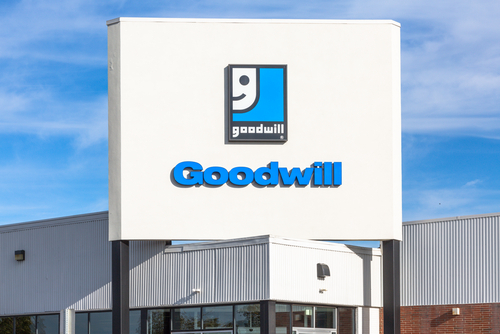After 2.5 years, Goodwill’s online marketplace GoodwillFinds abruptly closed. The brand’s CEO, retail veteran Matthew Kaness, shares wins and woes from the resale venture.
Matthew Kaness is no stranger to challenges. The retail veteran has more than two decades of experience at top retail and technology brands including Burton Snowboards, Urban Outfitters, Mod Cloth (CEO), Walmart, Afterpay, Lucky Brand, Anthropologie and Free People. His strength, he said, is leading brands through periods of innovation and growth.
His latest endeavor was as CEO of GoodwillFinds.com, the online counterpart of the well-known nonprofit thrift store Goodwill. Since its October 2022 debut, it had sold $60 million in gross merchandise value and boasted an impressive average order value of $150, Kaness said. Although GoodwillFinds.com shuttered in March, Kaness takes valuable lessons from leading the brand.
Kaness chatted with Multichannel Marketer on some of Goodwill Finds’ highlights and challenges.
How Goodwillfinds.com started
Goodwill Industries is one of the most widely recognized nonprofit organizations in the U.S., with more than 150 charity stores that resells donated apparel, home goods and other products at discounted prices. It also provides job training, employment placement services and other community-based programs for people who face barriers in their employment.
Through a licensing agreement with Goodwill, Kaness brought the Goodwill experience online at GoodwillFinds.com to introduce the brand to the next generation of shoppers and doners.
“The underlying theory for GoodwillFinds in the consumer market is, how cool would it be to thrift shop Goodwills across the country from the ease of your mobile device,” Kaness said. “I want to buy eyewear for a beach vacation: I go to GoodwillFinds and there’s the best donations from Miami Beach. Or, I want to wear a cool pair of cowboy boots and there’s assortment from Colorado.”
The ecommerce shop had a lot going for it, including large brand recognition, a steady stream of donated inventory, an established network of stores that has processes to receive and warehouse inventory.
Large challenges for GoodwillFinds
But these advantages were outweighed by large challenges including:
- Kaness only had purview over GoodwillFinds, and had no control over Goodwill’s previously established auction ecommerce site — ShopGoodwill.com. (The GoodwillFinds URL now forwards to this store, which is operated eBay-style by the Orange County Goodwill.)
- The target market for GoodwillFinds was not the same audience as the charity’s in-store shopping base.
- And perhaps the largest challenge: GoodwillFinds is a nonprofit and had limitations on what it could accept for capital and how to use it.
“It’s been really challenging as far as fundraising goes because there’s no equity to sell, so you can’t use traditional growth investment,” he said. “And there’s also, I’d say for a startup, there’s a lot of compliance and governance bureaucracy that comes with being a nonprofit that adds a lot of friction to a young company that’s trying to move quickly.”
He declined to share how much GoodwillFinds.com has raised. When Kaness chatted with Multichannel Marketer in early March, he said his next milestone was to secure more funding so it could scale. The operation shuttered two weeks later with no preamble.
GoodwillFinds was slow to scale
Kaness likened GoodwillFinds.com to a marketplace, in which all 153 of the Goodwill stores are their own marketplaces seller, with its own owner, but the same charity and brand affiliation.
It only onboarded and had inventory from about 20 Goodwill stores on the platform, including Los Angeles, Seattle, Chicago, Dallas, Fort Worth, Miami and New York. In contrast, the auction site ShopGoodwill.com showcased inventory from more than 100 Goodwills.
Goodwill Finds had to travel to each Goodwill to talk with the manager to get the store setup online with its software and backend process to list products on the site.
“It’s hard to scale it on the backend, especially when you’re subscale, but I’ve only come to know that there’s no stigma with the younger generation of online thrift shoppers for secondhand,” Kaness said.
Popularity for thrift and secondhand goods
Kaness pointed to the growth of online resale sales in the U.S. as evidence for Goodwill’s value proposition. EMarketer estimated U.S. consumers spent $80 billion on used goods in 2024. Popular online resellers include The RealReal, which sells used luxury brands and ThreadUp, which sells everyday apparel, and StockX, which sells sneakers. Plus, peer-to-peer marketplaces, such as Poshmark, have made online resale popular.
Kaness said the online shoppers of GoodwillFinds.com were not the typical price-sensitive shoppers in Goodwill stores.
“They’re into vintage and trends,” he said. “They care about shopping for brands because brands give them a trust about the size and the quality. As long as the information’s accurate, as far as the size and the condition, I’ll buy it. We’re getting incredible selling prices that the local Goodwills were just not getting before.”
In fact, Kaness said that it’s average selling price per product was more than $50, which is a far cry from the single-digit prices many shoppers are used to in-store at Goodwill.
Automation helps brands on shoestring budgets
Because every penny matters, the brand automated as much as possible for its team of less than 10 employees. It used artificial intelligence for dynamic pricing and for catalog augmentation to drive personalization and matching.
At the start of Q1, the brand rolled out a generative AI customer service chatbot that handled 70% of the inbound customer service inquires.
Shoppers were mainly finding Goodwill Finds “organically” and driving web traffic through earned media, he said. In the two years since launch, Goodwill Finds had 2 billion unique visitors with paid marketing that is “next to nothing,” he said.
The end for GoodwillFinds
Despite these efforts, on March 28, GoodwillFinds.com posted on its homepage that it was no longer accepting new orders and encouraged shoppers to visit ShopGoodwill.com and their local Goodwill store. A few weeks later, the GoodwillFinds URL just redirects to ShopGoodwill.com.
“I’ve loved the opportunity to promote a more sustainable future for the retail industry and amplify how younger consumers have shown real purchasing intent that supports sustainability for the first time in my career – by choosing to shop secondhand first,” he said. “There’s still a lot of work to do for our industry to meet that promise of a sustainable future, but technology is now solving the issue profitability and my belief is that those brands and merchants who embrace this cultural shift and adopt the new technologies will win.”
Kaness declined to give any comment on the record after GoodwillFinds shuttered.

 Network
Network

